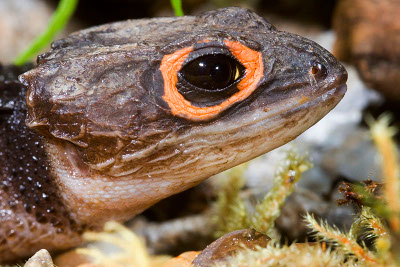New Guinea Crocodile Skink
Category: Lizard

Facts about New Guinea crocodile skink. "Scientific name for New Guinea crocodile skink is Tribolonotus gracilis". They are commonly known as red-eyed crocodile skink and is a shy reptile of the genus Tribolonotus and belongs to species gracilis. It is the most common species of all the other crocodile skinks. The New Guinea crocodile skink is most active early in the morning or late evening due to its shy nature. Just like humanss, it gets nervous easily and can even lose its tail, when it feels threatened, the reason for this is the tail squirms excessively and the New Guinea crocodile skink has time to escape. During the day, it can be found hiding under lumps of leaves or it can burrow in between spaces found in mass of trees in the forest. Under humid conditions, it can grow at an optimum rate to its maturity.
Physical appearance of New Guinea crocodile skink
A mature New Guinea crocodile skink will have grown to about 8 inches (20 cm) in length having a triangular head and its skin has a leathery feeling when touched. In most cases, females are slightly smaller than males with most of the New Guinea crocodile skinks having an average weight of 1 1/2 ounces (45 gram). The reptile can easily be identified by its bony projections which run from head to tail which are six of them. The New Guinea crocodile skink body is covered with spiny scales in most cases to deter its predators. Its eyes are red in color with the body color ranging from brown to being light as well as its scales. The New Guinea crocodile skink eyes are naturally unique due to the rings, orange in color, surrounding them. The neck and the underbellies also have a creamy color. However as they do mature their bodies generally darken.
Behavior of New Guinea crocodile skink
New Guinea crocodile skink is an arboreal reptile mainly ha-biting tropical forests and they can live in area heavily populated areas inhabited by human. When in serious danger or discomfort they are able to show this by producing a very loud sound vocally. The New Guinea crocodile skink is known for pretending to be dead when they are handled or freezing its body when frightened. The New Guinea crocodile skink can also excrete fecal material from its intestines to scare and to freeze its predator.
Geographical distribution of New Guinea crocodile skink
The New Guinea crocodile skink can be traced to be a native of southeastern Asia but due to actions and explorations of humankind, it has now been spread to other parts of the world including northern Irian jaya, Northern Papua New Guinea, and Karkar Island. It can also be found in parts of Indonesia Island and Solomon islands.
Reproduction of New Guinea crocodile skink
The New Guinea crocodile skink are sexually active after three to four years after reaching maturity. New Guinea crocodile skinks to be selected for reproductive purposes are identified by an orange coloration under their chins. Females lay eggs just one at a time and they are capable of laying a maximum of six eggs if nutrients are enough. The reason behind this is that the left oviduct and the ovary develop slowly in comparison to the right. The effect is that, the egg in the left ovary is laid after 60 days after the right ovary’s egg has been laid. Only one live offspring can be given birth by a female crocodile skink.
Diet of New Guinea crocodile skink
The New Guinea crocodile skink is a carnivore preying on insects and arthropods for example earthworms, darkling beetles, and silkworms. Vitamin D3 as well as calcium should be supplemented in the diet for proper growth of juveniles and hatchlings.

 Back To Category Lizard
Back To Category Lizard